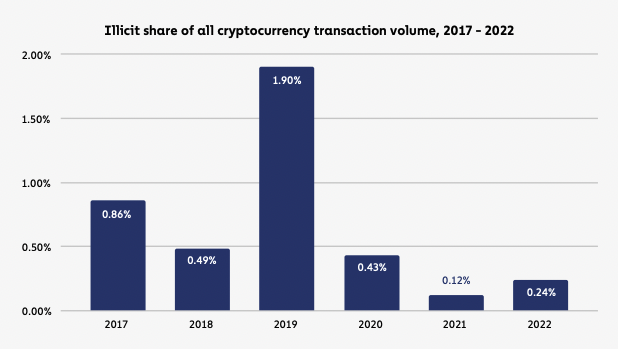The digital currency market, lauded for its transactional transparency and convenience, is increasingly exploited by malicious entities for nefarious ends.
Bitcoin used to be the preferred choice for terrorist financing, but new on-chain channels like NFTs are now emerging for this purpose.
In this statistics article, we’ll see all the patterns emerging of crypto and NFT financing terrorism activities.
Top Facts on Crypto Funding Terrorism

Here are the top 5 facts you need to know about crypto funding terrorism:
- In 2022, the total amount of crypto received by illicit addresses stood at $20.6 billion (+13.8% compared to 2021) (Chainanalysis)
- Official on-chain statistics mention that crypto-based terrorist funding activity declined by 90% between 2022 and 2021 (Chainanalysis)
- On-chain terrorist-related activity peaked in 2019 when it managed to grow by 215% yearly. (Chainanalysis)
- Al-Qassam Brigades, the armed wing of Hamas, received 40.2% of its funds from regular crypto exchanges. (Bloomberg)
- ITMC (one of Hamas’ propaganda units in Gaza) received 50.3% of its crypto funding from mixing services. (Chainanalysis)
How Terrorist Organizations Manage to Receive Crypto Funds
Various sources provide terrorist organizations with the crypto funds they need. From exchanges to P2P protocols, looking at two known terrorist cells paints a clear picture.

The on-chain activity directed toward terrorist-owned wallets saw a peak in 2019, rising by 215% compared to 2018.
In 2020, this number declined by a quarter (25%) compared to 2019.
The trend continued in 2021, with a yearly decline of terrorism-related on-chain activity equal to 32%.
In 2022, the decline was extremely high, with a 90% reduction in on-chain activity toward these wallets.
How Are the Al-Qassam Brigades Collecting Crypto Funds?
If we look at individual terrorist organizations, we can locate the origins of these crypto funds. For instance, the Al-Qassab Birgades (or AQB, the military wing of Hamas) received 40.2% of its funds from regular crypto exchanges in 2019.
Next in line, AQB received 31.3% of its funds from high-risk exchanges (i.e., crypto exchanges with little to no compliance).
Official statistics also mention a 13.8% share of funds going to AQB from unnamed services.
P2P exchanges, which were very popular in the first years of crypto adoption, accounted for 7.4% of the funds received by AQB.
Direct terrorism financing sources accounted for 4.9% of the crypto funds received by AQB.
It is also worth mentioning that a small – yet relevant – component (2.4%) of AQB crypto funds came from the so-called darknet markets.
How Is the Ibn Taymiyya Media Center Collecting Crypto Funds?
The picture remains similar if we switch our attention from armed groups to propaganda units. For instance, the Ibn Taymiyya Media Center (or ITMC, Hamas’ propaganda unit in the Gaza Strip) received 50.3% of crypto funds from mixing services in 2019.
Far back in line, the ITMC received 19.5% of its funds from regular exchanges.
Once again, so-called unnamed services provided a relevant part (17.5%) of crypto funds to the ITMC.
High-risk exchanges were also popular for the ITMC, with 10.2% of the crypto funds.
Like AQB, P2P exchanges were used to fund the ITMC in a small but relevant part (2.1%).
Finally, the darknet markets provided 0.4% of the crypto funds to the ITMC.
Sources: Bloomberg, Chainanalysis
Table 1: AQB and ITMC – Crypto Fund Sources
| Source | AQB | ITMC |
| Regular crypto exchanges | 40.2% | 19.5% |
| Crypto mixers | – | 50.3% |
| High-risk exchanges | 31.3% | 10.2% |
| Unnamed services | 13.8% | 17.5% |
| P2P exchanges | 7.4% | 2.1% |
| Direct terrorism financing | 4.9% | – |
| Darknet markets | 2.4% | 0.4% |
Shifting Away from Bitcoin
While Bitcoin (BTC) was the preferred choice for terrorist organizations, the data shows a gradual change in this sector. From Tether’s USDT to NFTs, terrorists evaluate different ways to finance their operations.

It seems that Palestinian combat groups received $130 million in crypto to finance the war in Israel in 2022-2023. However, there are studies suggesting that these numbers are likely overstated
Bitcoin use in terror financing rose by 78% from 2021 to 2022
The use of Tether USDT, as a comparison, grew by 240% in the same period in the terrorist world
In this context, Tether blocked 32 addresses linked to terrorism and warfare in Israel and Ukraine
The combined value of Tether’s frozen accounts was $873,118.

How Are Terrorists Exploiting NFTs?
Beyond Bitcoin, we also find non-fungible tokens (NFT) as a new source of on-chain funding for terrorist organizations. In September 2022, an NFT was used to share a terror message coming from the IS group.
The NFT, titled “IS-NEWS #01,” was a writing praising the mosque bomb attack that occurred in Kabul in August 2022, with 21 victims and over 30 injured people.
As of 2023, the NFT does not appear to have been traded, hinting at a low application of this technology in the terrorism financing field.
It is not the first time that terrorists have attempted to pursue this strategy: in the early 2010s, the “Rare Pepe” crypto art collections – linked to far-right terrorism – appeared through the “Counterparty” protocol even before the launch of NFT technology.
In December 2020, an anonymous French donor gave over $500,000 in BTC to far-right entities.
Among these, $9,400 went to an anonymous holder of a BTC Rare Pepe collectible.
Sources: BeInCrypto, Reuters, Coindesk, The Wall Street Journal, Elliptic
Recommended Stats
Bitcoin (BTC) has been the most popular cryptocurrency for terrorism. However, recent data shows an attempt to experiment with the more stable USDT tokens.
Yes, Tether managed to spot and block 32 addresses that were linked to warfare and terrorism in Ukraine and Israel.
On-chain activity for terrorist-related operations peaked in 2019, with subsequent strong declines until 2022.
There has been at least one known case of an NFT used by a terrorist organization. In 2022, an NFT praising a terrorist attack by the IS group appeared online and was never traded.
Many countries have little or no regulation in the crypto market, making the anonymous nature of blockchain particularly appealing to criminals.






